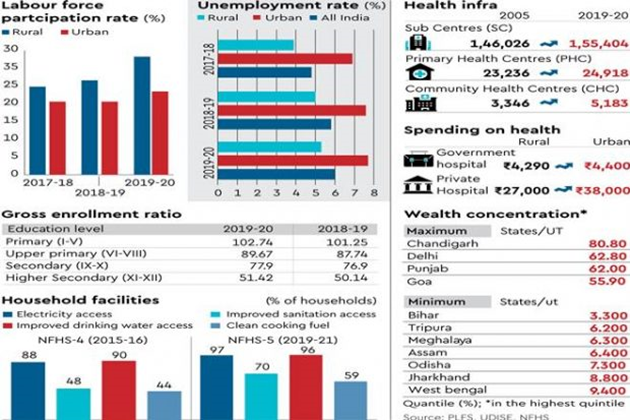

19th May 2022 (6 Topics)
Context
The State of Inequality in India Report has been recently released.
About
About State of Inequality in India Report:
- Written by: Institute for Competitiveness.
- The report presents a holistic analysis of the depth and nature of inequality in India. It consists of two parts:
- Economic Facets
- Socio-Economic Manifestations
- The report looks at five key areas that influence the nature and experience of inequality. These are:
- income distribution
- labour market dynamics,
- health,
- education
- household characteristics
- The report moves beyond the wealth estimates that depict only a partial picture to highlight estimates of income distribution over the periods of 2017-18, 2018-19 and 2019-20.
- With a first-time focus on income distribution to understand the capital flow, the report emphasises that wealth concentration as a measure of inequality does not reveal the changes in the purchasing capacity of households.
Key Findings:
- The State of Inequality in India Report concedes that while earnings have risen over the years, the benefits of that growth have largely remained concentrated and this has marginalised the poor further.
- While progress has been made in various indicators — from improved labour participation (pre-Covid), health infrastructure and enrolment ratio of students to child mortality — wealth concentration has worsened.
- A 44.4% wealth concentration in the highest quintile in urban areas is contrasted with a meagre 7.1% concentration in that in rural India.
- Nutrition profile among children has improved compared to 2015-16 (NFHS 4), like stunting in children has gone down from 38.4% and wasting from 21%, and 7.7% are severely wasted.
- Additionally, 32.1% of children (under five years) were reported to be underweight.
- As per Rural Health Statistics 2019-20, as of March 2020, there are 155404 Sub Centres (SC), 24918 Primary Health Centres (PHC), and 5183 Community Health Centres (CHC) in rural India.
- In 2019-20, the Gender Parity Index was more than 1 across all levels of education at the all-India level.
- The Gender Parity Index (GPI) based on GER reflects the representation of females in schools in relation to the population of girls in the corresponding age group.
- A value of 1 shows a favourable picture, while anything less than 1 shows relative underrepresentation.
- India’s unemployment rate is 4.8% (2019-20), and the worker population ratio is 46.8%.
- In 2019-20, among different employment categories, the highest percentage was of self-employed workers (45.78%), followed by regular salaried workers (33.5%) and casual workers (20.71%).
- The share of self-employed workers also happens to be the highest in the lowest income categories.

More Articles



